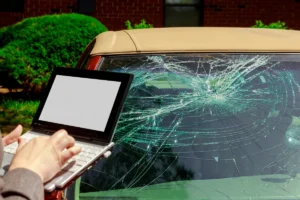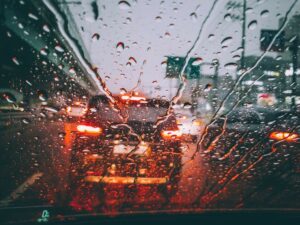Unexpected encounters with birds or branches can leave unsightly damage on your car’s windshield. Auto glass damage can range from minor chips to full-blown cracks, and knowing how to navigate these situations is crucial for maintaining the safety and integrity of your vehicle.
In this guide, we’ll explore different types of damage caused by such incidents, how to identify the severity, and when to opt for repair versus replacement.
Types of Auto Glass Damage
Auto glass damage can manifest in various forms, each requiring a different approach for repair or replacement. Here are the most common types:
1. Chips
Chips are small, often circular damages caused by debris or small objects like pebbles. They can appear anywhere on the windshield and are usually less than a quarter in size. While they may seem small, chips can spread over time, leading to more severe cracks.
2. Cracks
Cracks are lines that extend across the windshield, and they can vary in length and direction. They often start from the edges of the glass and extend inward. Cracks can significantly weaken the structural integrity of the windshield and obstruct the driver’s view.
3. Combination Breaks
Combination breaks are a mix of chips and cracks. They occur when the impact causes both a small crater and radiating cracks. These types of damages are more complex and can require a more detailed assessment to determine the appropriate repair method.
4. Star Breaks
Star breaks have a central point with several cracks radiating outward, resembling a star. These can be caused by larger debris or more forceful impacts. Star breaks can compromise the structural integrity of the windshield if not addressed quickly.
Causes of Auto Glass Damage
Auto glass damage can be caused by a variety of factors, including:
1. Bird Strikes
Bird strikes occur when a bird collides with the windshield. The impact can range from a minor chip to a severe crack, depending on the size of the bird and the speed of the vehicle. Bird strikes are unpredictable and often happen when driving at high speeds.
2. Falling Branches
Branches can fall onto your vehicle during storms or strong winds, causing significant damage to the windshield and other windows. The severity of the damage depends on the size and weight of the branch.
3. Road Debris
Small rocks, pebbles, and other debris kicked up by other vehicles can strike your windshield, leading to chips and cracks. This is a common cause of minor auto glass damage, especially when driving on highways or gravel roads.
4. Accidents
Minor fender benders or more serious collisions can cause extensive damage to your windshield and other auto glass. Even a minor impact can lead to cracks that compromise the safety of your vehicle.
Assessing the Severity of Auto Glass Damage
Understanding the severity of the damage is important in determining the appropriate course of action. Here are some factors to consider:
1. Size and Depth
The size and depth of the chip or crack are important indicators of the severity. Generally, chips smaller than a quarter and cracks less than three inches long can often be repaired. Larger damages usually require a full replacement.
2. Location
The location of the damage is critical. Chips and cracks in the driver’s line of sight or near the edges of the windshield are more serious and often require replacement to ensure safety and structural integrity.
3. Spread
If the damage is spreading or spidering out from the initial impact point, it’s more likely that a replacement will be needed. Spreading cracks can quickly compromise the entire windshield.
Repair vs. Replacement
Deciding between repair and replacement depends on the severity and location of the damage. Here’s a guideline to help you decide:
When to Repair
- Small Chips: Chips smaller than a quarter can typically be repaired.
- Short Cracks: Cracks less than three inches long can often be repaired if they are not in the driver’s line of sight.
- Minor Star Breaks: Star breaks that are not spreading and are less than three inches in diameter can be repaired.
When to Replace
- Large Chips: Chips larger than a quarter usually require replacement.
- Long Cracks: Cracks longer than three inches, especially those spreading from the edges, need replacement.
- Driver’s Line of Sight: Any damage that impairs the driver’s visibility should prompt a replacement for safety reasons.
- Multiple Damages: If there are multiple chips or cracks, replacement is often the safer option.
File name: car-accident
Alt-text: person stranded with a broken down car
The Importance of Quick Action
Addressing auto glass damage immediately is essential for several reasons:
1. Safety
A damaged windshield can impair visibility and weaken the structural integrity of your vehicle. In the event of an accident, an intact windshield helps protect the occupants by preventing ejection and supporting the roof.
2. Preventing Further Damage
Small chips and cracks can spread over time due to temperature changes, vibrations, and additional impacts. Repairing minor damage early can prevent the need for more costly replacements later.
3. Cost-Effective
Repairing a small chip or crack is generally less expensive than replacing the entire windshield. Quick action can save you money and time in the long run.
Conclusion
Understanding the different types of auto glass damage and knowing when to opt for repair versus replacement is crucial for maintaining the safety and integrity of your vehicle.
If you’re looking for professional Auto Glass repairs in San Antonio, Auto Glass in San Antonio is an excellent option. With over 30 years of experience in delivering the finest auto glass repair and replacement services, our team of technicians is eager to assist you with your windshield repair.
Moreover, we also offer mobile windshield repair and replacement services at your doorstep at affordable prices. Get a free quote for our premium services today!





